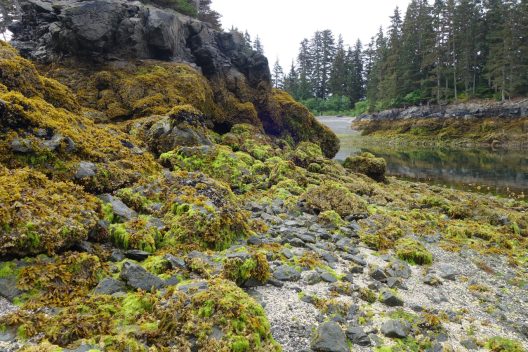Counting Snails in Alaska

Written by SMEA Professor, Terrie Klinger
In March, 1989, the T/V Exxon Valdez famously—and catastrophically—ran aground on Bligh Reef in the Gulf of Alaska. All sorts of agencies and entities initiated all sorts of emergency responses to investigate the incident, remove the oil, and assess damages to marine and cultural resources, among other objectives. The region was ill-prepared for the intense activity that ensued—manpower was scant, available boats were too few, and communications infrastructure was inadequate. Even so, crews were sent to locations around the Gulf to clean shorelines and record impacts.
Fast-forward a full decade: NOAA’s Office of Response and Restoration in 1999 initiated a new study to better understand how the spill may have affected intertidal communities dominated by rockweed, mussels, and barnacles and how long those effects may have persisted. I was among a group of scientists that traveled to Kasitsna Bay to establish a sampling program to help answer such questions. We established 36 permanent plots along the shore of a small island and estimated the abundance of each species in each plot. We cleared some plots and not others to try to emulate the effects of oil-induced mortality. We came back each summer for seven years to record changes over time, and in doing so, answered NOAA’s initial questions.
But at the end of seven years, I realized the growing value of the time-series we had created. Ours was the longest series of intertidal observations available for this region, and in a time of accelerating climate change, it seemed foolish to abandon the sampling program. So we kept at it, one summer after the next. The time-series begun in 1999 now is in its 25th year. We have seen the ecological effects of a marine heatwave and are witnessing other changes, for example, in the abundance of periwinkle snails (yes, we spend a large amount of time counting very small snails). The major players in the system—rockweed, mussels, and barnacles—persist, although their relative abundance changes from year to year. We’ve seen indications of the influence of physical conditions—air and water temperatures, freshwater discharge—on the intertidal biota, including the effects of a cold regime that preceded the marine heatwave. We’ve not (yet) witnessed the arrival of invasive species nor observed wholesale losses from this intertidal system that sits at the edge of a warming Arctic. Meanwhile, our understanding of the dynamics of the Gulf of Alaska continues to grow based on contributions from a host of investigators around Alaska—an understanding that can help us respond to ocean conditions as they change in the future.